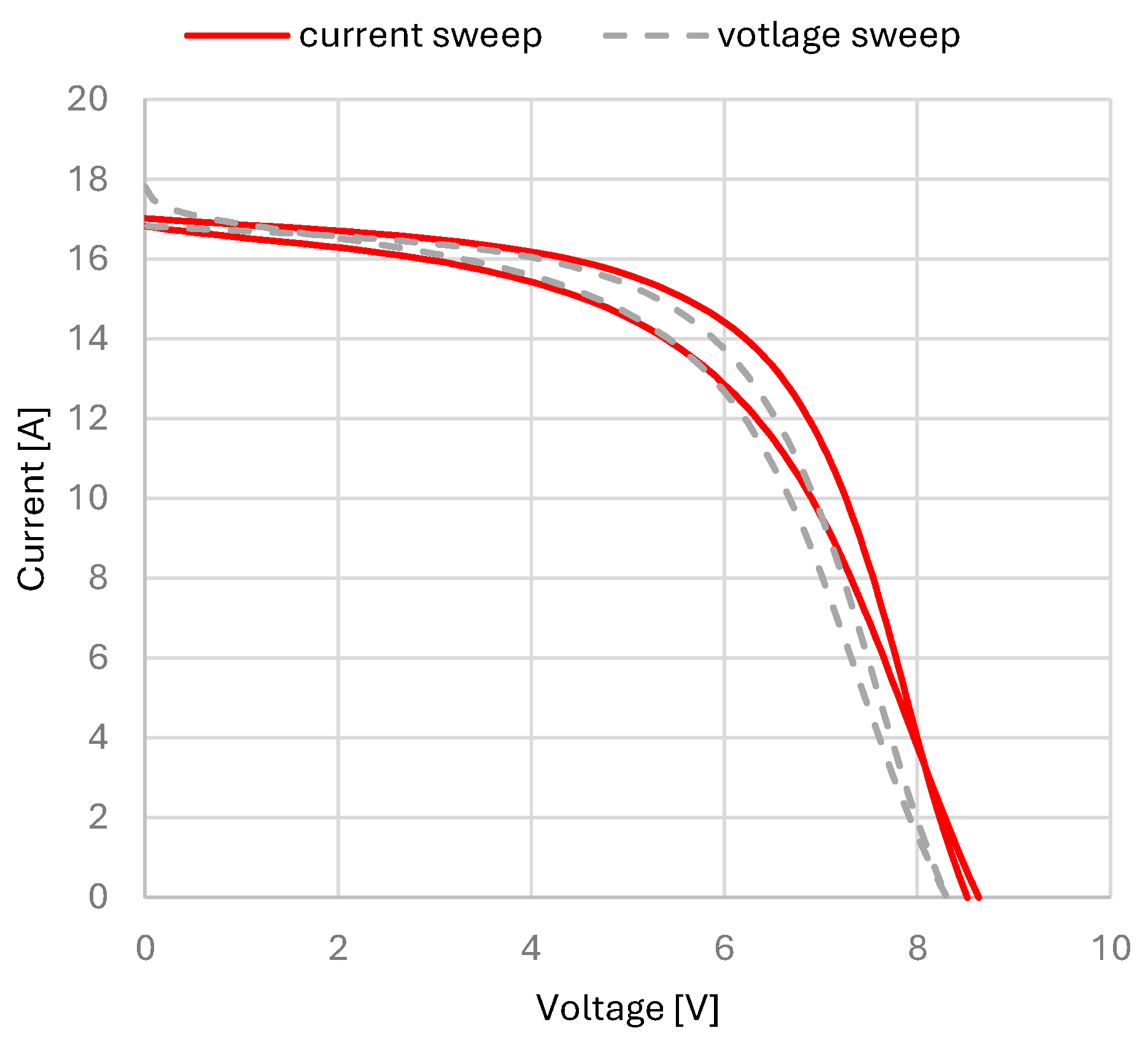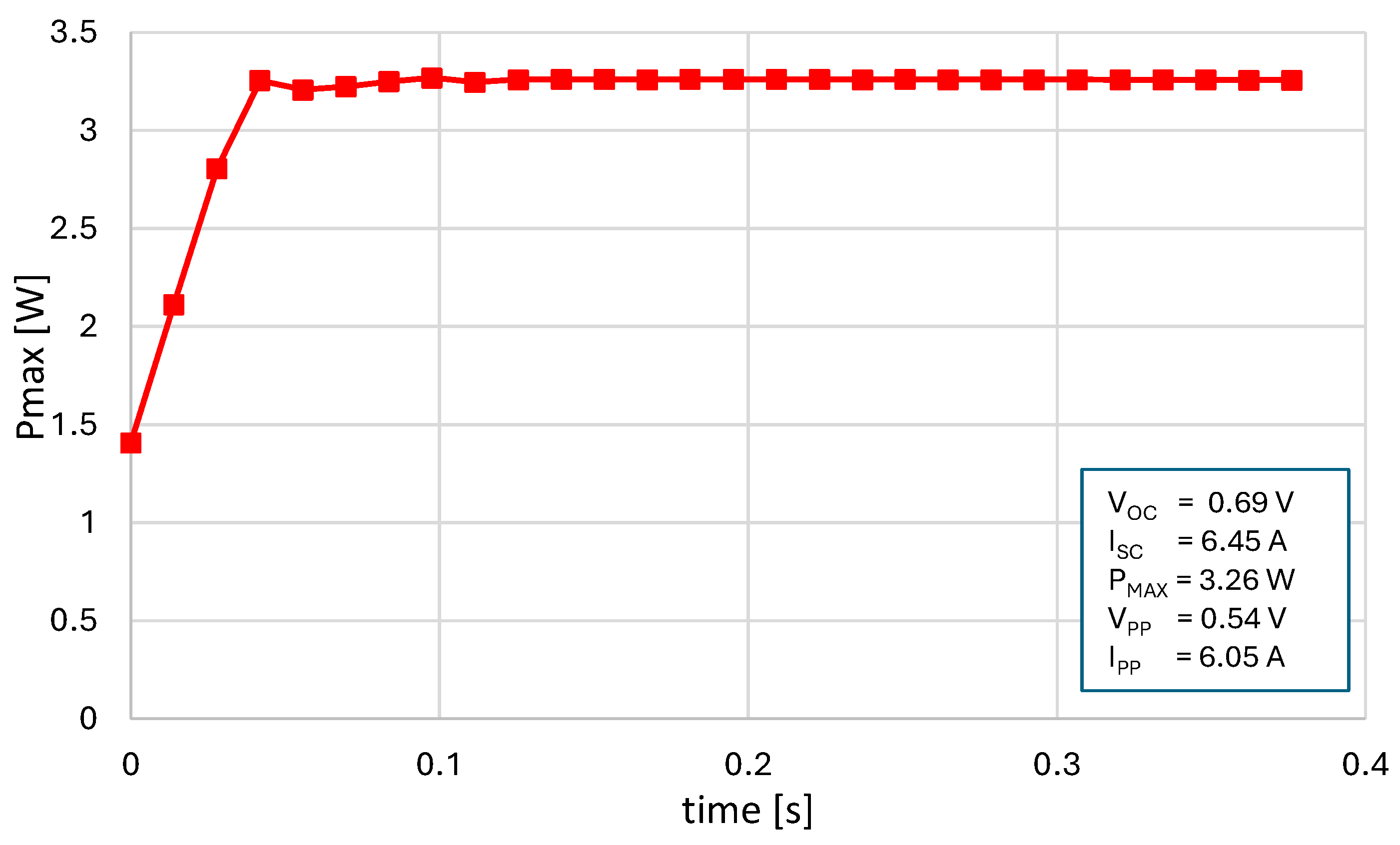Quality Assessment of Perovskite Solar Cells: An Industrial Point of View
Abstract
1. Introduction
2. Materials and Methods
2.1. Perovskite Mini-Module Fabrication
2.2. Electrical Characterizations
3. Results and Discussion
- Illuminate the PV device with a calibrated solar simulator.
- Individually evaluate the short-circuit current ISC by forcing 0 V across the device terminals and measuring the corresponding current.
- Individually evaluate the open-circuit voltage VOC by forcing 0 A across the device terminals and measuring the corresponding voltage.
- Perform a Fast-MPPT until the output power stabilizes with the desired precision (e.g., 10 µW).
- Write a report with the measured ISC, VOC, PMAX, IPP, VPP.
4. Conclusions
Author Contributions
Funding
Institutional Review Board Statement
Informed Consent Statement
Data Availability Statement
Conflicts of Interest
References
- Best Research-Cell Efficiency Chart|Photovoltaic Research|NREL. Available online: https://www.nrel.gov/pv/assets/images/cell-pv-eff-emergingpv.jpg (accessed on 2 August 2024).
- Zhu, H.; Teale, S.; Lintangpradipto, M.N.; Mahesh, S.; Chen, B.; McGehee, M.D.; Sargent, E.H.; Bakr, O.M. Long-Term Operating Stability in Perovskite Photovoltaics. Nat. Rev. Mater. 2023, 8, 569–586. [Google Scholar] [CrossRef]
- Green, M.A.; Dunlop, E.D.; Hohl-Ebinger, J.; Yoshita, M.; Kopidakis, N.; Bothe, K.; Hinken, D.; Rauer, M.; Hao, X. Solar Cell Efficiency Tables (Version 60). Prog. Photovolt. Res. Appl. 2022, 30, 687–701. [Google Scholar] [CrossRef]
- Alberi, K.; Berry, J.J.; Cordell, J.J.; Friedman, D.J.; Geisz, J.F.; Kirmani, A.R.; Larson, B.W.; McMahon, W.E.; Mansfield, L.M.; Ndione, P.F.; et al. A Roadmap for Tandem Photovoltaics. Joule 2024, 8, 658–692. [Google Scholar] [CrossRef]
- Khenkin, M.V.; Katz, E.A.; Abate, A.; Bardizza, G.; Berry, J.J.; Brabec, C.; Brunetti, F.; Bulović, V.; Burlingame, Q.; Di Carlo, A.; et al. Consensus Statement for Stability Assessment and Reporting for Perovskite Photovoltaics Based on ISOS Procedures. Nat. Energy 2020, 5, 35–49. [Google Scholar] [CrossRef]
- IEC 60904-1:2020; Photovoltaic Devices—Part 1: Measurement of Photovoltaic Current-Voltage Characteristics. International Electrotechincal Commisson: Geneva, Switzerland. Available online: https://webstore.iec.ch/en/publication/32004 (accessed on 7 July 2020).
- Fell, C.J. Standardising Current-Voltage Measurements for Metastable Solar Cells. J. Phys. Energy 2020, 2, 011002. [Google Scholar] [CrossRef]
- IEC TR 63228:2019; Measurement Protocols for Photovoltaic Devices Based on Organic, Dye-Sensitized or Perovskite Materials. International Electrotechincal Commisson: Geneva, Switzerland. Available online: https://webstore.iec.ch/en/publication/64040 (accessed on 21 June 2024).
- Di Girolamo, D.; Vidon, G.; Barichello, J.; Di Giacomo, F.; Jafarzadeh, F.; Paci, B.; Generosi, A.; Kim, M.; Castriotta, L.A.; Frégnaux, M.; et al. Breaking 1.7 V Open Circuit Voltage in Large Area Transparent Perovskite Solar Cells Using Interfaces Passivation. Adv. Energy Mater. 2024, 14, 2400663. [Google Scholar] [CrossRef]
- Di Giacomo, F.; Castriotta, L.A.; Matteocci, F.; Di Carlo, A. Beyond 99.5% Geometrical Fill Factor in Perovskite Solar Minimodules with Advanced Laser Structuring. Adv. Energy Mater. 2024, 14, 2400115. [Google Scholar] [CrossRef]
- Hosseini, S.H.; Farakhor, A.; Khadem Haghighian, S. Novel Algorithm of MPPT for PV Array Based on Variable Step Newton-Raphson Method through Model Predictive Control. In Proceedings of the 2013 13th International Conference on Control, Automation and Systems (ICCAS 2013), Gwangju, Republic of Korea, 20–23 October 2013; pp. 1577–1582. [Google Scholar] [CrossRef]
- IEC 60904-9:2020; Photovoltaic Devices—Part 9: Classification of Solar Simulator Characteristics. International Electrotechincal Commisson: Geneva, Switzerland. Available online: https://webstore.iec.ch/en/publication/28973 (accessed on 7 July 2020).
- IEC 60904-7:2019; Photovoltaic Devices—Part 7: Computation of the Spectral Mismatch Correction for Measurements of Photovoltaic Devices. International Electrotechincal Commisson: Geneva, Switzerland. Available online: https://webstore.iec.ch/en/publication/65654 (accessed on 21 August 2019).
- Kang, D.H.; Park, N.G. On the Current–Voltage Hysteresis in Perovskite Solar Cells: Dependence on Perovskite Composition and Methods to Remove Hysteresis. Adv. Mater. 2019, 31, 1805214. [Google Scholar] [CrossRef] [PubMed]
- Rizzo, A.; Lamberti, F.; Buonomo, M.; Wrachien, N.; Torto, L.; Lago, N.; Sansoni, S.; Pilot, R.; Prato, M.; Michieli, N.; et al. Understanding Lead Iodide Perovskite Hysteresis and Degradation Causes by Extensive Electrical Characterization. Sol. Energy Mater. Sol. Cells 2019, 189, 43–52. [Google Scholar] [CrossRef]
- Lago, N.; Polo, A.; Reddy, S.H.; Di Carlo, A.D.; Cester, A. Intrinsic Instability of Perovskite Solar Cells: The Role of a Hole-Blocking Layer. Crystals 2023, 13, 185. [Google Scholar] [CrossRef]




Disclaimer/Publisher’s Note: The statements, opinions and data contained in all publications are solely those of the individual author(s) and contributor(s) and not of MDPI and/or the editor(s). MDPI and/or the editor(s) disclaim responsibility for any injury to people or property resulting from any ideas, methods, instructions or products referred to in the content. |
© 2024 by the authors. Licensee MDPI, Basel, Switzerland. This article is an open access article distributed under the terms and conditions of the Creative Commons Attribution (CC BY) license (https://creativecommons.org/licenses/by/4.0/).
Share and Cite
Lago, N.; Moretti, F.; Tormena, N.; Caria, A.; Buffolo, M.; De Santi, C.; Trivellin, N.; Cester, A.; Meneghesso, G.; Zanoni, E.; et al. Quality Assessment of Perovskite Solar Cells: An Industrial Point of View. Photonics 2024, 11, 880. https://doi.org/10.3390/photonics11090880
Lago N, Moretti F, Tormena N, Caria A, Buffolo M, De Santi C, Trivellin N, Cester A, Meneghesso G, Zanoni E, et al. Quality Assessment of Perovskite Solar Cells: An Industrial Point of View. Photonics. 2024; 11(9):880. https://doi.org/10.3390/photonics11090880
Chicago/Turabian StyleLago, Nicolò, Francesco Moretti, Noah Tormena, Alessandro Caria, Matteo Buffolo, Carlo De Santi, Nicola Trivellin, Andrea Cester, Gaudenzio Meneghesso, Enrico Zanoni, and et al. 2024. "Quality Assessment of Perovskite Solar Cells: An Industrial Point of View" Photonics 11, no. 9: 880. https://doi.org/10.3390/photonics11090880
APA StyleLago, N., Moretti, F., Tormena, N., Caria, A., Buffolo, M., De Santi, C., Trivellin, N., Cester, A., Meneghesso, G., Zanoni, E., Meneghini, M., Matteocci, F., Barichello, J., Vesce, L., Di Carlo, A., & Quartiani, F. (2024). Quality Assessment of Perovskite Solar Cells: An Industrial Point of View. Photonics, 11(9), 880. https://doi.org/10.3390/photonics11090880











